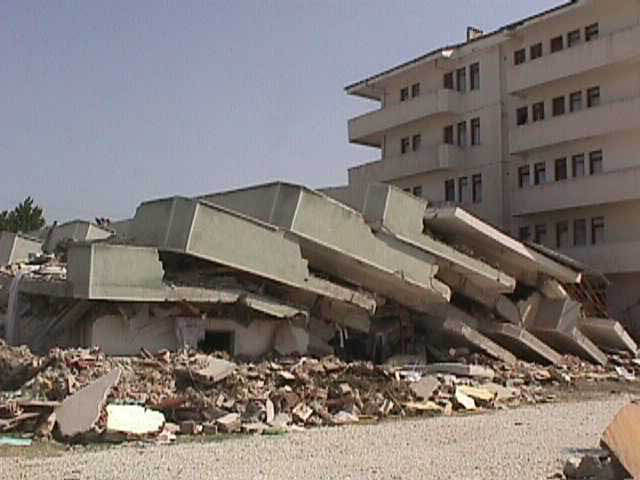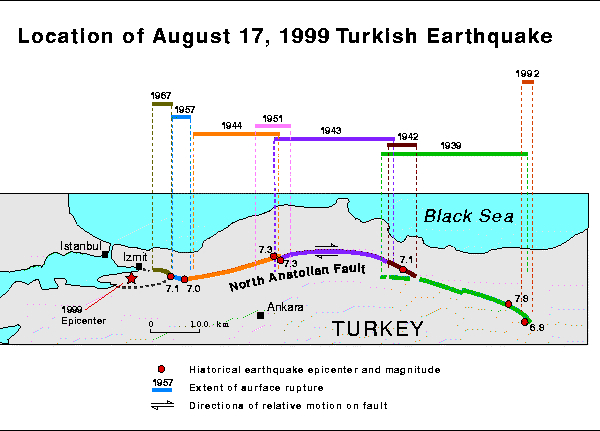
Flashpoint Found for Istanbul's Next Earthquake

As violent protests rock Istanbul, another cataclysm is building beneath the city.
Just 30 miles (50 kilometers) from the center of Istanbul, the last domino is waiting to fall on the North Anatolian Fault. Since 1939, massive temblors have marched westward on the fault, moving closer to the city. When this section of the fault finally topples, an earthquake of more than magnitude 7.0 will strike one of Europe's biggest cities. Now, researchers think they've pinpointed the spot where the earthquake will start, according to a study published today (June 18) in the journal Nature Communications.
The likely epicenter is a seismically dead zone on the Princes Island segment of the North Anatolian Fault, just south of Istanbul in the Sea of Marmara. After four years of "listening" with earthquake monitors, researchers failed to detect any microearthquakes (down to magntitude-1.8) on a patch 18 miles wide by 6 miles deep (30 km by 10 km) of the Princes Island segment.
"We have identified an entirely aseismic patch of the fault," said Marcos Bohnhoff, a seismologist at the GFZ German Research Centre for Geosciences in Potsdam. "It's very likely that if this patch runs off, it will activate the whole [fault]," he said.
There are a couple explanations for the quiet patch. According to one, the fault is creeping along, moving slowly, without triggering earthquakes. But from earlier studies, as well as evidence from past earthquakes that occurred in the very same spot, Bohnhoff and his colleagues are sure the fault is not a creeper. Their explanation is much more dire: a locked fault, building up pressure as it's squeezed between two tectonic plates.

The 745-mile-long (1,200 km) North Anatolian Fault is one of the biggest strike-slip faults in the world, on the scale of California's San Andreas Fault. The fissure marks the boundary between the Eurasian and Anatolian tectonic plates. The Anatolian plate looks like a watermelon seed, scooting westward toward the Mediterranean as the bigger Eurasian and Arabian tectonic plates push toward one another.
The Princes Island segment is one of three sections of the Northern Anatolian Fault ready to break apart the next time the fault triggers an earthquake. Knowing which of the three dominoes will fall first can help researchers better understand and model the coming earthquake, Bohnhoff said. [7 Ways the Earth Changes in the Blink of an Eye]
Sign up for the Live Science daily newsletter now
Get the world’s most fascinating discoveries delivered straight to your inbox.
"We're not trying to predict an earthquake. We've known that there is an earthquake coming for years," Bohnhoff told OurAmazingPlanet. "We're trying to better characterize it, so we can optimize the things that can be done to minimize the impact," he said.
But seismologist Volkan Sevilgen, who was not involved in the study, thinks more work needs to be done on the other two dominoes — the fault's other segments — before researchers can truly forecast which segment will rupture in a future earthquake.
"We also need to consult the alternatives," said Sevilgen, who runs Seismicity.net. "It's a really a nice study, and I agree they found a seismic gap, but it's possible we could have an earthquake on any section of the North Anatolian Fault," he said.
The earthquake forecast models vary, so predictions range from 35 to 70 percent for the chances of a magnitude-7 earthquake in Istanbul by 2034. The last big quake was in Izmit, in 1999. More than 30,000 people died then, and damage was estimated at up to $6.5 billion.
Email Becky Oskin or follow her @beckyoskin. Follow us @OAPlanet, Facebook & Google+. Original article on LiveScience's OurAmazingPlanet.











